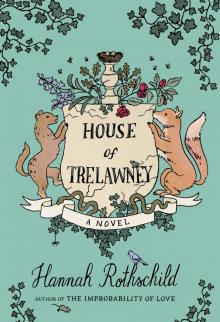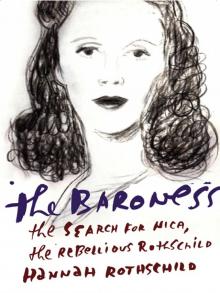- Home
- Hannah Rothschild
The Baroness
The Baroness Read online
The Baroness
Nica, photographed in Mexico, 1947, age thirty-four (Photographic Credit col1.1)
This Is a Borzoi Book
Published by Alfred A. Knopf
Copyright © 2012 by Hannah Rothschild
All rights reserved. Published in the United States by Alfred A. Knopf,
a division of Random House, Inc., New York, and in Canada by
Random House of Canada Limited, Toronto.
www.aaknopf.com
Knopf, Borzoi Books, and the colophon are registered trademarks of Random House, Inc. Originally published, in slightly different form, in hardcover in the United Kingdom by Virago Press, an imprint of Little, Brown Book Group, an Hachette UK Company, London, in 2012.
Library of Congress Cataloging-in-Publication Data
Rothschild, Hannah, [date]
The baroness: the search for Nica, the rebellious Rothschild / by Hannah Rothschild.
pages cm
Includes bibliographical references
eISBN: 978-0-307-96199-0
1. Koenigswarter, Pannonica de. 2. Rothschild family. 3. Women music patrons—Great Britain—Biography. 4. Music patrons—Great Britain—Biography. I. Title.
ML 429.K72R68 2013
781.65092—dc23
[B] 2012036881
Jacket illustration by Vivienne Flesher
Jacket lettering by Ward Schumaker
Jacket design by Carol Devine Carson
v3.1
For Jacob and for Serena
Contents
Cover
Title Page
Copyright
Dedication
The Rothschilds Selective Family Tree
1 The Other One
2 Queen of the Fleas
3 The Rose of Hungary
4 Fight, Flee, Flounder
5 Long, Dark Prison
6 Rothschildiana
7 The Butterfly and the Blues
8 Pure Pre-War Perfection
9 The Commander-in-Chief
10 You’re the Top
11 Stormy Weather
12 Pistol-Packing Mama
13 Take the A-Train
14 Black, Brown and Beige
15 A Blast
16 Loneliest Monk
17 Black Bitch, White Bitch
18 Bird
19 Pannonica
20 Strange Fruit
21 Blood, Sweat and Tears
22 Gotten Me Crazy
23 Luvya
24 ’Round Midnight 245 Epilogue
A Selection of Songs Written for or Inspired by Nica
Acknowledgements
Interviews
Bibliography
Documentaries and Film Footage
Archives and Libraries
Photographic Credits
A Note About the Author
The Rothschilds
SELECTIVE FAMILY TREE
1 • The Other One
My grandfather Victor was the first person to mention her. He was trying to teach me a simple twelve-bar blues chord but my eleven-year-old hands were leaden and too small.
“You’re like my sister,” he said. “You love jazz but can’t be arsed to learn to play it.”
“Which sister? Miriam or Liberty?” I asked, trying to ignore the barb.
“No, the other one.”
What other one?
Later that day I found her in the Rothschild family tree: Pannonica.
“Who is Pannonica?” I asked my father, Jacob, her nephew.
“She is always called Nica but beyond that I don’t really know,” he said. “No one ever talks about her.” Our family is so large and scattered that he did not seem surprised to have mislaid a near relation.
I was not put off. I pestered another great-aunt, Nica’s sister Miriam, the renowned scientist, who divulged, “She lives in New York,” but would not offer any further information. Another relation told me, “She’s a great patron, the Peggy Guggenheim or Medici of jazz.”
Then there were the whispers:
She’s known as “the Jazz Baroness.” She lives with a black man, a pianist. She flew Lancaster bombers in the war. That junkie saxophonist Charlie Parker died in her apartment. She had five children and lived with 306 cats. The family cut her off (no they didn’t, someone countered). Twenty songs were written for her (no, it was twenty-four). She raced Miles Davis down Fifth Avenue. Did you hear about the drugs? She went to prison so he wouldn’t have to. Who’s he? Thelonious Monk. It was a true love story, one of the greatest.
“So what is Nica like?” I asked Miriam again.
“Vulgar. She is vulgar,” Miriam said crossly.
“What does that mean?” I persisted.
Miriam would not elaborate but she did give me her sister’s number. When I went to New York for the first time in 1984 I rang Nica within hours of arriving.
“Would you like to meet up?” I asked nervously.
“Wild,” she answered in a decidedly un-great-aunt, un-seventy-one-year-old way. “Come to the club downtown after midnight.”
This area had yet to be gentrified and was known for its crack dens and muggings.
“How will I find it?” I asked.
Nica laughed. “Look out for the car,” and hung up.
The car was impossible to miss. The large, pale-blue Bentley was badly parked and inside it two drunks lolled around on the leather seats.
“It’s good they’re in there—it means no one will steal the car,” she explained later.
Set back from the street was a small door leading down to a basement. I knocked loudly. Minutes later a hatch opened in the upper door and a dark face appeared behind a grille.
“What?” he said.
“I’m looking for Pannonica,” I said.
“Who?”
“Pannonica!” I repeated in slightly desperate English tones. “They call her Nica.”
“You mean the Baroness! Why didn’t you say so?” The door swung open to reveal a tiny basement room, shabby, smoky and cramped, where several people sat listening to a pianist.
“She’s at her table.”
Nica, the only white person, was easy to spot, sitting nearest the stage.
She hardly resembled the woman I had studied in our family photograph albums. That Nica was a ravishing debutante, her raven hair tamed and dressed, her eyebrows plucked into fashionable arches and her mouth painted to form a perfect bee-stung pout. In another portrait, a less soignée Nica, her hair loose and face free of make-up, seemed more like a Hollywood version of a Second World War double agent. The Nica before me looked nothing like her younger self; her astonishing beauty had since waned and now those once-delicate features bordered on the masculine. Her voice will always stay with me, a voice that had been pummelled like a shoreline by waves of whisky, cigarettes and late nights, a voice that was part rumble, part growl, and was frequently punctuated by wheezy bursts of laughter.
Nica in 1942 (Photographic Credit 1.1)
Smoking a cigarette in a long black filter, her fur coat draped over the back of a spindly chair, Nica gestured to an empty seat and, picking up a teapot from the table, poured something into two chipped china cups. We toasted each other silently. I’d been expecting tea. Whisky bit into my throat; I choked and my eyes watered. Nica threw back her head and laughed.
“Thanks,” I croaked.
She put her finger to her lips and, nodding at the stage, said, “Sssh, just listen to the music, Hannah, just listen.”
At the time, I was twenty-two and failing to live up to the expectations, real or imagined, of my distinguished family. I felt inadequate, incapable of making it in my own right, yet unable to make the most of the privilege and opportunity available to me. Like Nica, I was b
arred from working in the family bank; the founding father N. M. Rothschild had decreed that Rothschild women were only allowed to act as bookkeepers or archivists. Caught in a holding pattern between university and employment, I was keen to work at the BBC but I managed only to collect letters of rejection. Although my father, who had followed in the family tradition of banking, found me jobs through various contacts, I was hopeless at running a bookshop, property development or cataloguing artworks. Depressed and disheartened, I was not trying to find a role model, but I was looking for options. At the heart of my search was a question. Is it possible to escape from one’s past or are we forever trapped in layers of inherited attitudes and ancient expectation?
I gazed across the table at this newly discovered great-aunt and felt a sudden, inexplicable surge of hope. A stranger walking into the club would merely have seen an old lady sucking on a cigarette, listening to a pianist. They might have wondered what this fur-coated, pearl-wearing dame was doing, swaying to the music, nodding appreciatively at a particular solo. I saw a woman who seemed at home and who knew where she belonged. She gave me this piece of advice: “Remember, there is only one life.”
Shortly after our first meeting I went back to England, where I finally got a job at the BBC and began making documentaries. Again and again my thoughts turned to Nica. In those days, before the Internet and cheap transatlantic airfares, travelling to America and maintaining friendships across continents were difficult. We met at her sister Miriam’s house at Ashton Wold in England as well as once more on my next trip to New York. I sent Nica postcards; she sent me records, including one called Thelonica: an album by Tommy Flanagan and a musical tribute to her friendship with the jazz pianist Thelonious Monk. One of the album tracks was “Pannonica.” On the back she’d written: “To dear Hannah, Lots of love, Pannonica.” I wondered about Thelonious and Pannonica. How had two such strangely named people with disparate pasts ever come to meet? What could they have had in common?
She asked me to play the record for my grandfather Victor, who only commented that he quite liked it. “He didn’t really get Monk either,” Nica said. I enjoyed my role as a musical go-between from brother to sister. Another time she asked me to give my grandfather one of the pianist Barry Harris’s records. He gave it another duff review. Next time I saw her, I told her. “I give up,” Nica said dismissively. “He only likes trad.” Then she roared with laughter.
Nica was fun. She lived in the moment, she was not reflective or didactic, and she did not seek to burden you with her knowledge or her experiences. It was a relief compared to being with her brother Victor or her sister Miriam, where encounters became an intellectual assault course, a mental decathlon in which you were required to show how much you knew and how well you could display your rationale, thinking, knowledge and bravura. When I got into Oxford University my grandfather called me to ask, “Which scholarship did you get?” I admitted that I had been lucky to scrape a place. He hung up, disappointed. In her ninety-fourth year Miriam asked how many books I was writing. None yet, I said, but I was making another film. “I’ve done too many of those to count,” she said. “I am writing ten books, including one on Japanese haiku.” Then she hung up.
I did not know anything much about jazz but Nica never made me feel “uncool” or “unhip” or care that I had no idea what dig, cat, fly, zoot, tubs, Jack and goof meant. But she was absolutely adamant about one thing: Thelonious Monk was a genius, up there with Beethoven. She called him “the Einstein of music.” If there were seven wonders in the world, she said, he was the eighth.
When I was planning a trip to New York in December 1988 to do some filming for a documentary about the art world, I set aside three nights to hang out with Nica and had saved up questions to ask her. But then, on November 30, 1988, she died suddenly, following a heart bypass operation. I had missed my opportunity.
Those unposed questions continued to haunt me. There would be unexpected reminders: a glimpse of the New York skyline in a feature film; a refrain from a Monk song; seeing her daughter Kari; the scent of whisky. While I spent my professional life making filmed portraits of other people, both dead and alive, another plan was percolating. I made films about collectors, artists and outsiders, subjects and themes that were relevant to Nica and her story. Perhaps her untimely death did not mean the end of our relationship. Perhaps those questions could be posed posthumously to her surviving friends and relations.
Slowly I started to piece together an outline of her life. She was born in 1913, before the First World War, at a time when our family was at the height of its power. She had a cosseted, pampered childhood, living in art-filled mansions. Later she married a handsome baron, by whom she had five children, and they had owned a fabulous chateau in France; she wore designer frocks and jewels, flew aeroplanes, drove sports cars and rode horses. Part of a glamorous high society, she lived in a cosmopolitan world peopled by tycoons, royalty, the intelligentsia, politicians and playboys. She could meet anyone, go anywhere, and she often did. To those who have little or nothing, such an existence must seem like paradise. Yet one day in 1951, without warning, she gave it all up and went to live in New York, where she swapped her upper-class friends for a group of brilliant, itinerant black musicians.
Nica and Thelonious Monk, 1968 (Photographic Credit 1.2)
She vanished from British life, only keeping in touch with her children and close family members. The next glimpse most people got of Nica was when her antics were splashed across the newspapers. “Bop King Dies in Baroness’s Boudoir” made headlines on both sides of the Atlantic, as did reports that she was going to prison for possession of narcotics. She reappeared, played by an actress, in Clint Eastwood’s biopic Bird and then as herself in the documentary Straight, No Chaser. The original footage was shot in 1968 by two brothers, Christian and Michael Blackwood, who, using a handheld camera, followed Monk from his bed to the concert hall, through airports and backstreets, capturing on celluloid the flotsam and jetsam of his daily life. The footage included scenes with his friend, the Baroness Nica de Koenigswarter, née Rothschild.
In this footage I got my first glimpse of Thelonious Monk. Hovering in the background was my great-aunt.
“Do you know who she is?” the High Priest of Jazz asks the camera crew as he dances around the tiny basement. Weighing over 220 pounds, standing six feet four, the pianist looks both out of scale and graceful as he whirls about in a sharp suit, beads of perspiration glinting on his dark skin. Monk hums as he moves from the sink to the table, his heavy gold rings clunking against a glass of whisky. Suddenly, full of purpose, he turns to the camera.
“I said, do you know who she is?” he barks at the film crew.
No one replies, so Monk points across the room. The camera follows his gaze to settle on a white woman, Nica, who is surrounded by four black men in this kitchen-cum-dressing room, the waiting area between street and performance. The camera takes in the scene; there is not an ounce of glamour in the place with its bare light bulb and stack of unwashed dishes. Nor does the woman look like your usual rock chick or groupie: she is the wrong side of forty; her hair hangs lankly to her shoulders; the stripy T-shirt and jacket do not do much for her comely figure. She certainly does not resemble either an heiress or a femme fatale.
“She a Rothschild, you know,” Monk persists. “Her family laid the bread on the King to beat Napoleon.” Then turning back to Nica, he says, “I tell everyone who you are, I’m proud of you.”
“Don’t forget they threw in the Suez Canal for good measure,” she replies, clearly a little drunk. Nica looks at Monk with a mixture of love and admiration before returning to the task of getting a cigarette into her mouth.
“But that was over a year or more ago,” interjects a younger musician. “Here, have the Suez Canal,” Nica says, clamping the cigarette with her front teeth and holding out an imaginary canal in her hand. “That’s a bitch,” the younger guy comments.
“I tell everyone who you are,�
� Monk says. For a man whose first language is supposed to be silence he’s remarkably voluble. “You know who she is?” Monk asks again, walking towards the camera just in case anyone isn’t concentrating. “She’s a billionaire, a Rothschild.”
I have watched this footage many times, searching for clues about Nica and trying to imagine the reaction of her old friends and extended family. I asked my father Jacob, what did everyone think?
“We didn’t talk about her much,” he said.
But when you heard that she had been sent to prison or when the famous saxophonist was found dead in her apartment? I pressed.
My father hesitated. “I suppose we were all rather bemused and slightly shocked.”
I turned amateur detective. What had taken Nica from the grandest drawing room to the shabbiest cellar? Leaving had real consequences. Divorce, at that time, was a fast track to social ostracism, and the custody of children was rarely given to absconding women. With no qualifications or career, Nica was dependent on her family for support. Was there a terrible secret, some dark reason why she had to be suddenly rushed out of the country and into this foreign environment?
Maybe she was mad. She had made some fairly dotty public statements. Asked by a journalist why her marriage ended, Nica replied, “My husband liked drum music.” She told the filmmaker Bruce Ricker that the catalyst for her moving to New York was hearing a record. “I must have played it twenty times in a row and then more. I missed my plane and never went home.”
“She bought Art Blakey a Cadillac and you know what that means,” someone told me.
What exactly are you saying?
“Well, you don’t just buy someone a car, do you?” he said knowingly.
There were other rumours about other men. What if I found out that my aunt was nothing more than a dilettante, a permissive woman attracted by a certain lifestyle? Suppose that was all there was?

 House of Trelawney
House of Trelawney The Baroness
The Baroness The Improbability of Love
The Improbability of Love